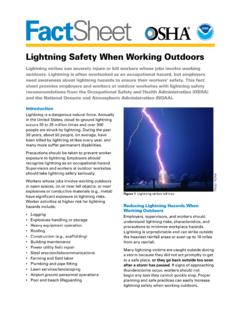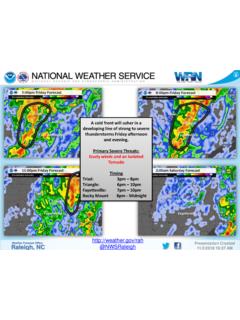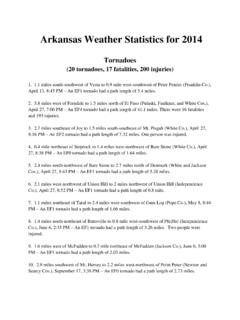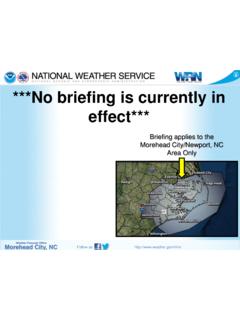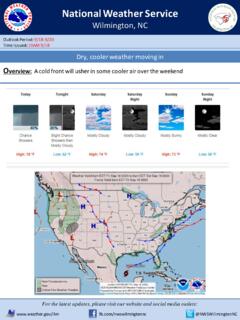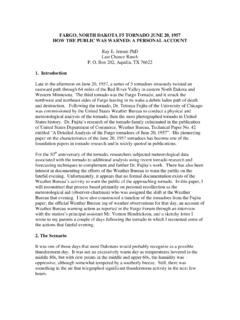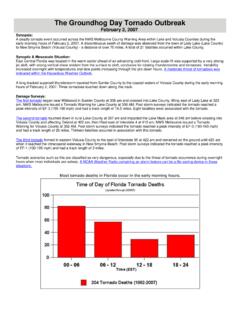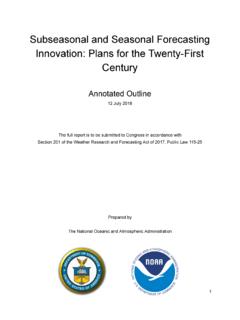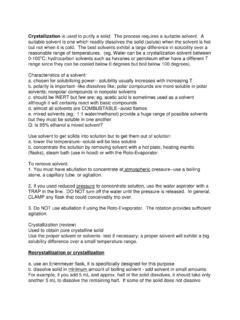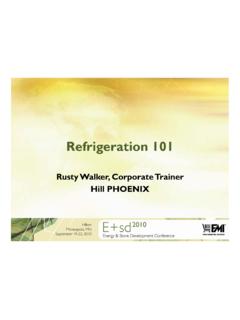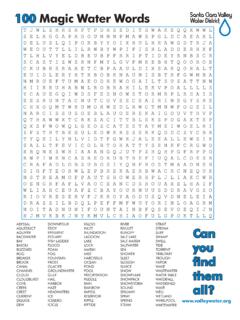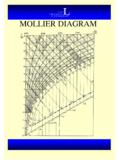Transcription of A. Fog Types - National Weather Service
1 A. Fog Types Fog is often described as a stratus cloud resting near the ground. Fog forms when the temperature and dew point of the air approach the same value ( , dew-point spread is less than 5 F) either through cooling of the air (producing advection, radiation, or upslope fog) or by adding enough moisture to raise the dew point (producing steam or frontal fog). When composed of ice crystals, it is called ice fog. (1) Advection fog. Advection fog forms due to moist air moving over a colder surface, and the resulting cooling of the near-surface air to below its dew-point temperature. Advection fog occurs over both water ( , steam fog) and land. (2) Radiation fog (ground or valley fog). Radiational cooling produces this type of fog. Under stable nighttime conditions, long-wave radiation is emitted by the ground; this cools the ground, which causes a temperature inversion.
2 In turn, moist air near the ground cools to its dew point. Depending upon ground moisture content, moisture may evaporate into the air, raising the dew point of this stable layer, accelerating radiation fog formation. (3) Upslope fog (Cheyenne fog). This type occurs when sloping terrain lifts air, cooling it adiabatically to its dew point and saturation. Upslope fog may be viewed as either a stratus cloud or fog, depending on the point of reference of the observer. Upslope fog generally forms at the higher elevations and builds downward into valleys. This fog can maintain itself at higher wind speeds because of increased lift and adiabatic cooling. Upslope winds more than 10 to 12 knots usually result in stratus rather than fog. The east slope of the Rocky Mountains is a prime location for this type of fog.
3 (4) Steam fog (arctic sea smoke). In northern latitudes, steam fog forms when water vapor is added to air that is much colder, then condenses into fog. It is commonly seen as wisps of vapor emanating from the surface of water. This fog is most common in middle latitudes near lakes and rivers during autumn and early winter, when waters are still warm and colder air masses prevail. A strong inversion confines the upward mixing to a relatively shallow layer within which the fog collects and assumes a uniform density. Under these conditions, the visibility is often 3/16 mile (300 meters) or less. (5) Frontal fog. Associated with frontal zones and frontal passages, this type of fog can be divided into three Types : warm-front pre-frontal fog; cold front post-frontal fog; and frontal-passage fog.
4 Pre and post-frontal fog are caused by rain falling into cold stable air thus raising the dew point. Frontal passage fog can occur in a number of situations: when warm and cold air masses, each near saturation, are mixed by very light winds in the frontal zone; when relatively warm air is suddenly cooled over moist ground with the passage of a well marked precipitation cold front; and in low-latitude summer, where evaporation of frontal-passage rain water cools the surface and overlying air and adds sufficient moisture to form fog. (6) Ice fog. Ice fog is composed of ice crystals instead of water droplets and forms in extremely cold, arctic air ( 29 C ( 20 F) and colder). Ice fog of significant density is found near human habitation, in extremely cold air, and where burning of hydrocarbon fuels adds large quantities of water vapor to the air.
5 Steam vents, motor vehicle exhausts, and jet exhausts are major sources of water vapor that produce ice fog. A strong low level inversion contributes to ice fog formation by trapping and concentrating the moisture in a shallow layer. In summary, the following characteristics are important to consider when forecasting fog: Synoptic situation, time of year, and station climatology. Thermal (static) stability of the air, amount of air cooling and moistening expected, wind strength, and dew-point depression. Trajectory of the air over Types of underlying surfaces ( , cooler surfaces or bodies of water). Terrain, topography, and land surface characteristics. B. Fog Characteristics A general summary of characteristics important to fog formation and dissipation are given here. This is followed by general fog forecasting guidance and guidance specific to advection, radiation, and frontal fogs.
6 (1) Formation. Fog forms by increasing moisture and/or cooling the air. Moisture is increased by the following: Precipitation. Evaporation from wet surfaces. Moisture advection. Cooling of the air results from the following: Radiational cooling. Advection over a cold surface. Upslope flow. Evaporation. (2) Dissipation. Removing moisture and/or heating the air dissipates fog and stratus. Moisture is decreased by the following: Turbulent transfer of moisture downward to the surface ( , to form dew or frost). Turbulent mixing of the fog layer with adjacent drier air. Advection of drier air. Condensation of the water vapor to clouds. Heating of the air results from the following: Turbulent transport of heat upward from air in contact with warm ground. Advection of warmer air. Transport of the air over a warmer land surface.
7 Adiabatic warming of the air through subsidence or downslope motion. Turbulent mixing of the fog layer with adjacent warmer air aloft. Release of latent heat associated with the formation of clouds. (3) General Forecasting Guidance. In general: Fog may thin after sunrise when the lapse rate becomes moist adiabatic in the first few hundred feet above ground. Fog lifts to stratus when the lapse rate approaches dry adiabatic. Marked downslope flow prevents fog formation. The moister the ground, the higher the probability of fog formation. Atmospheric moisture tends to sublimate on snow, making fog formation less likely. Rapid formation or clearing of clouds can be decisive in fog formation. Rapid clearing at night after precipitation is especially favorable for the formation of radiation fog.
8 The wind speed forecast is important because speed decreases may lead to the formation of radiation fog. Conversely, increases can prevent fog, dissipate radiation fog, or increase the severity of advection fog. A combination advection-radiation fog is common at stations near warm water surfaces. In areas with high concentrations of atmospheric pollutants, condensation into fog can begin before the relative humidity reaches 100 percent. The visibility in fog depends on the amount of water vapor available to form droplets and on the size of the droplets formed. At locations with large amounts of combustion products in the air, dense fog can occur with a relatively small water vapor content. After sunrise, the faster the ground temperature rises, the faster fog and stratus clouds dissipate.
9 Solar insolation often lifts radiation fog into thin multiple layers of stratus clouds. If solar heating persists and higher clouds do not block surface heating, radiation fog usually dissipates. Solar heating may lift advection fog into a single layer of stratus clouds and eventually dissipate the fog if the insolation is sufficiently strong. (4) Specific Forecasting Guidance. Consider the following when faced with advection, radiation, or frontal fog situations. (a) Advection Fog. Advection fog is relatively shallow and accompanied by a surface based inversion. The depth of this fog increases with increasing wind speed. Other favorable conditions include: Light winds, 3 to 9 knots. Greater turbulent mixing associated with wind speeds more than 9 knots usually cause advection fog to lift into a low stratus cloud deck.
10 Coastal areas where moist air is advected over water cooled by upwelling. During late afternoon, such fog banks may be advected inland by sea breezes or changing synoptic flow. These fogs usually dissipate over warmer land; if they persist through late afternoon, they can advect well inland after evening cooling and last until convection develops the following morning. In winter when warm, moist air flows over colder land. This is commonly seen over the southern or central United States and the coastal areas of Korea and Europe. Because the ground often cools by radiation cooling, fog in these areas is called advection-radiation fog, a combination of radiation and advection fogs. Warm, moist air that is cooled to saturation as it moves over cold water forms sea fog: If the initial dew point is less than the coldest water temperature, sea fog formation is unlikely.

